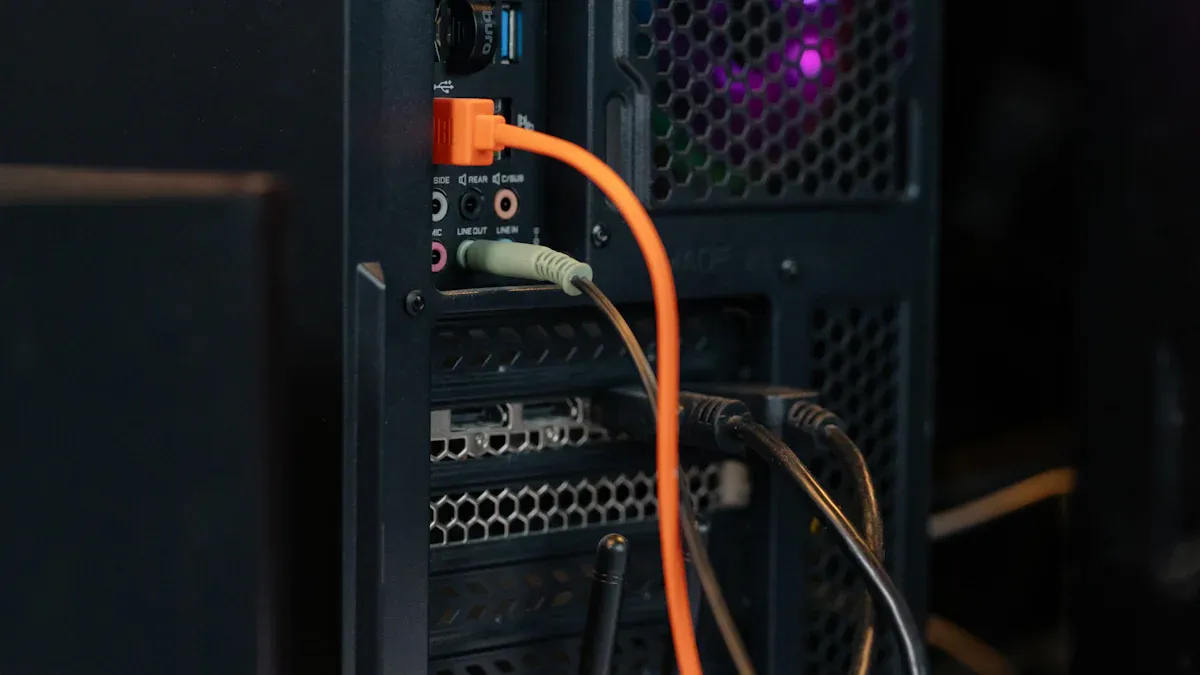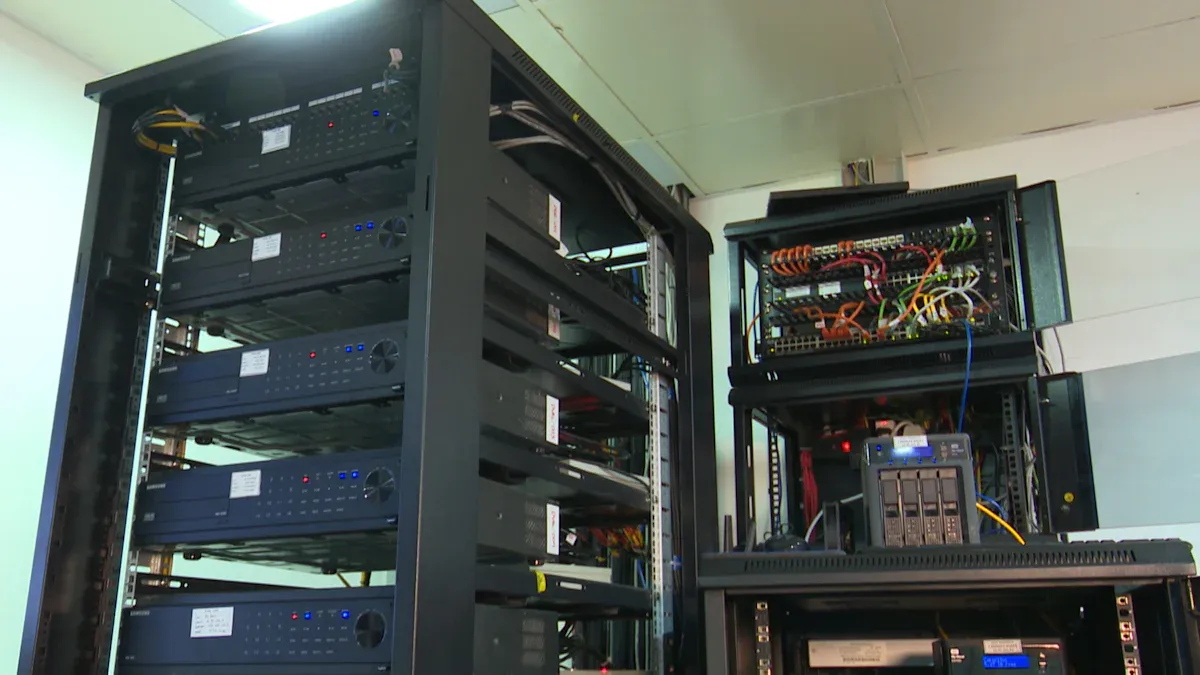© Copyright – 2010-2023 : All Rights Reserved. Sitemap
Power Distribution Unit PDU, rack mount PDU, PDU data center, Smart PDu, intelligent PDU
Power Distribution Unit PDU, rack mount PDU, PDU data center, Smart PDu, intelligent PDU
DTI-CX 2025 Digital Transformation Indonesia Conference, DATE:6-7 AUG.2025, Booth No.: C21

Selecting the right vertical rack mount PDU C13 is a critical task for your infrastructure. A single power outage can cost a business an average of $9,000 per minute, making a reliable power distribution unit essential. You must first understand your facility’s power requirements. While a basic PDU may cover simple setups, advanced systems often require PDU monitoring to track performance and prevent downtime. Next, you need to determine the number of outlets for current and future equipment. This vertical PDU must also fit your rack’s dimensions perfectly. The rapid growth of the PDU market highlights the increasing importance of making the correct choice for your vertical setup.
| Metric | Value |
|---|---|
| Market Size in 2024 | USD 4.8 Billion |
| Projected Revenue in 2030 | USD 8.5 Billion |
| Compound Annual Growth Rate | 9.6% (2024–2030) |
Before you choose a PDU, you must first understand your facility’s power environment. This initial step ensures your new equipment works safely and efficiently. Matching the PDU to your power source prevents costly damage and downtime.
You need to verify the voltage your facility provides to the server racks. Power standards differ globally, so this is a crucial first check. A PDU designed for one voltage will not work with another.
Note: In North America, single-phase outlets are typically 120V. In Europe, they are usually 230V. A common voltage in U.S. data centers is 208V, which is derived from a three-phase power source.
Confirming your facility’s voltage ensures you select a compatible PDU from the start.
Next, you must calculate your total power requirements. You can find the power draw of your equipment by using a simple formula: amps * volts = watts. Add the wattage of all devices you plan to connect to the PDU. This total helps you determine the necessary amperage.
Most data centers use three-phase power because it is more efficient and cost-effective for high-density loads. A three-phase system can deliver more power with smaller, more manageable wiring compared to a single-phase system. This makes installation easier and reduces costs. Balancing your equipment loads across the phases is essential for stable operation.
Finally, the PDU’s input plug must match the receptacle at your facility. Different power configurations use specific plug types to prevent incorrect connections. Examine your power outlet to identify the correct plug. Common types include various NEMA and IEC 60309 connectors.
Choosing the right plug is the final step in matching your PDU to your infrastructure’s power specifications.
After defining your power specifications, you must determine the number of outlets your setup requires. This count directly influences which vertical pdu you will choose. A precise calculation prevents you from running out of connection points.
First, you need to count every device in your rack that uses a C13 power cord. You should create a detailed inventory. This simple action gives you a clear baseline for your outlet needs.
This list provides the minimum number of C13 outlets your new pdu must have. A thorough count ensures no device is left without power.
Your IT needs will grow over time. You should always plan for future expansion when selecting a pdu. Buying a unit with only the exact number of outlets you need today is a common mistake. It forces you to purchase another pdu sooner than expected.
💡 Pro Tip: A good rule of thumb is to choose a PDU with 25-50% more outlets than you currently need. For example, if you have 16 devices, you should look for a PDU with at least 20 to 24 outlets.
This extra capacity gives you flexibility. You can add new servers or upgrade equipment without worrying about power port availability. This foresight saves you time and money in the long run. It makes your infrastructure scalable and ready for future demands.

An ideal vertical PDU C13 does more than just supply power; it must also fit perfectly within your server rack. A PDU that is too long or improperly mounted can obstruct access, block airflow, and create a disorganized mess. You need to verify the physical dimensions to ensure a clean and efficient installation.
First, you must measure the height of your server rack to select a PDU of the appropriate length. Rack height is measured in rack units (U), where one U equals 1.75 inches (44.45 mm). A standard full-size rack is typically 42U tall, but sizes can vary.
You should choose a PDU that matches your rack’s internal height. This ensures the unit fits neatly without extending beyond the usable space.
💡 Did You Know? The EIA-310-D standard defines the specifications for 19-inch server racks. It sets the dimensions for rack height, width, and mounting hole spacing. A PDU that is EIA-310D compliant guarantees it will fit securely in any standard 19-inch rack, making installation straightforward.
Next, you need to confirm the PDU is designed for 0U vertical mounting. 0U PDUs, also known as vertical PDUs, mount in the space between the rack rails and the side panels. This placement is highly beneficial because it does not consume any valuable equipment mounting space (U-space).
This 0U vertical mounting approach offers several key advantages:
A well-designed vertical PDU streamlines your setup, enhances cooling, and leaves ample room for both equipment and effective cable management.
After confirming the physical fit, you must select the right type of PDU. Your choice depends on your need for monitoring and remote control. Each type offers a different level of functionality, from simple power delivery to complete network oversight.
A Basic PDU is the most straightforward option. It reliably distributes power from a single input to multiple outputs. You should choose this pdu when you prioritize simplicity and cost savings. It does not have monitoring features or a network connection. This makes it a cost-effective solution for smaller setups.
Basic PDUs are the best choice in several common situations:
| Scenario | Reason for Suitability |
|---|---|
| Small Server Rooms | Provides affordable and easy-to-use power distribution. |
| Office Setups | Delivers straightforward power without unneeded features. |
| Low-Density Racks | Meets simple power needs effectively. |
| Startups & Small Businesses | Offers reliability and helps decrease operational costs. |
A Metered PDU gives you the ability to see power consumption data. It features a local display that shows information like current, voltage, and power usage for the entire unit. Some advanced models offer outlet-level metering. This provides a very detailed view of your power consumption.
This granular data is crucial for capacity planning. You can identify underutilized servers and accurately assign power costs to specific departments. This process, known as chargeback, makes each business unit accountable for its energy use.
A Monitored PDU provides the same features as a Metered PDU but adds remote access. You can connect this vertical pdu to your network. This allows you to view power data from anywhere using a web browser. This type of vertical pdu c13 uses standard network protocols to communicate.
This remote capability allows the vertical unit to integrate with Data Center Infrastructure Management (DCIM) software. This gives you a single, centralized view of your entire power chain, helping you monitor health and react to issues proactively.
A Switched PDU gives you the highest level of command over your rack equipment. This type of pdu includes all the features of a Monitored PDU and adds the ability to remotely control individual outlets. You can turn outlets on, off, or reboot them from any location with a network connection. This capability is a game-changer for managing IT infrastructure efficiently.
The primary benefit is the power to resolve issues without needing a technician on-site. You can instantly reboot a frozen server or power cycle an unresponsive network switch. This remote control drastically reduces downtime and operational costs. Many businesses see a 20-30% decrease in IT operating expenses by eliminating the need for costly “remote hands” service calls. A recent survey showed that data centers using remote services saw a 40% improvement in maintenance response times.
This powerful remote access requires strong security measures. You must protect your vertical pdu c13 from unauthorized use.
With a Switched vertical unit, you can manage power for a wide range of devices. You can remotely provision power for new servers, restore service to digital signs, or reboot network controllers. This complete control makes your operations more resilient and cost-effective.

An exceptional vertical PDU C13 offers more than just power; it includes features that enhance reliability, safety, and manageability. You should look beyond the basic specifications to find a unit that truly protects your investment. These key features can prevent common problems and simplify data center operations.
You must select a power distribution unit with the right input cord length for your rack. A cord that is too short will not reach the power receptacle, while one that is too long creates unnecessary clutter. Standard PDU cord lengths vary, but a common best practice is to choose a length that minimizes slack. This ensures a clean setup and prevents tangled cables from blocking airflow. Any extra cord should be neatly managed with a cable organizer to maintain an orderly rack environment.
Accidental disconnections can cause serious downtime. You should choose a PDU with features designed to keep power cords secure. High-retention outlets grip plugs more tightly than standard outlets. Locking outlets provide an even higher level of security.
🔒 Secure Connections: IEC C13 locking connectors are a popular solution. They use a special mechanism to lock the cord into any standard C13 port, making the connection resistant to pulls and vibrations. This simple push/pull design prevents accidental power loss to critical servers and network gear during routine maintenance.
These locking mechanisms are essential in busy data centers. They ensure your equipment remains powered, protecting your business from the significant financial losses associated with unexpected outages.
The environment inside your server rack directly impacts equipment lifespan and reliability. A PDU with environmental monitoring capabilities helps you protect your hardware from heat and humidity. You can connect external sensors to the PDU to track conditions in real time.
This proactive monitoring allows you to:
Maintaining optimal conditions not only improves reliability but can also reduce cooling costs by 10-15%. For most data center equipment, you should aim to stay within the recommended ranges set by ASHRAE.
| Equipment Class | Recommended Temperature | Recommended Relative Humidity |
|---|---|---|
| A1–A4 | 18–27°C (64.4–80.6°F) | 50–70% |
By integrating environmental sensors with your power distribution unit, you gain valuable insight into your rack’s health and ensure a stable operating environment.
When you select a power distribution unit, you should look beyond its features. The build quality of the pdu is just as important. A well-made unit protects your expensive equipment and ensures consistent operation. You invest in reliability when you choose a durable pdu.
The materials used to build a pdu directly affect its safety and performance. You should look for units made with strong and resilient components. High-quality construction provides a solid foundation for your power infrastructure.
🛡️ Key Material Indicators:
A pdu built with these materials can withstand the demanding environment of a data center. It provides a safer and more dependable power source for your critical systems.
A durable pdu has a direct impact on your operational stability. Cheaply made units are more likely to fail. A failure can cause unexpected downtime and damage your servers. You want a pdu that you can trust to perform day after day.
A reliable pdu is a long-term investment. It may cost more initially, but it saves you money over time. You avoid the costs of frequent replacements, equipment damage, and business interruptions.
Choosing a well-constructed unit ensures it will last for many years. This longevity provides a better return on your investment. It also gives you peace of mind, knowing your infrastructure is powered by a device built for continuous, heavy-duty use.
Choosing a brand is the final major step in your selection process. You should evaluate a manufacturer’s reputation, product offerings, and support policies. This research ensures you partner with a company that stands behind its products.
You should start by researching the reputation of different PDU manufacturers. A strong reputation often indicates high-quality products and reliable performance. One of the best ways to judge a company’s commitment to quality is by checking for third-party certifications.
Look for marks like UL, CE, and TUV on a power distribution unit. These certifications mean the product has passed strict, independent tests for safety and performance. A pdu with these marks meets international standards, giving you confidence in its construction and reliability.
As you explore your options, you will find manufacturers like NBYOSUN that offer a wide range of solutions. With over two decades of experience, NBYOSUN provides high-quality PDUs for data centers and server rooms. Their product lines are designed to meet various needs.
Finally, you must consider the warranty and customer service. A strong warranty protects your investment. In the industry, many manufacturers offer a standard warranty of two to three years for their enterprise-grade pdu models. This coverage ensures you can get a replacement if the unit fails due to a manufacturing defect. Good customer service is also vital. You want a responsive support team that can help you with technical questions or warranty claims, minimizing any potential downtime.
Selecting the right vertical pdu c13 is a critical step for a reliable IT infrastructure. You can make an informed decision by evaluating your power requirements. A well-chosen vertical pdu from a trusted brand like NBYOSUN ensures stable power delivery. This power distribution unit protects your valuable equipment. You are now prepared to confidently select the ideal vertical pdu c13, a power distribution unit that fits your vertical setup and pdu needs perfectly.
A C13 outlet powers common devices like servers and switches. It handles up to 10A. A C19 outlet is for high-power equipment like blade chassis and supports up to 16A. You must check your equipment’s power cord to see which outlet you need.
A 0U PDU is a vertical PDU. It mounts in the side space of your server rack. This design does not use any main equipment space (measured in “U”). It saves room for your servers and helps improve airflow around your equipment.
You need a Switched PDU if you want to control individual outlets remotely. This feature lets you reboot a frozen server from anywhere. If you only need to view power usage, a Metered or Monitored PDU is a more cost-effective choice for your setup.
Certifications like UL mean an independent lab has tested the PDU for safety. This mark shows the product meets high-quality standards. It gives you confidence that the PDU will protect your valuable equipment and operate reliably in your data center.
A Professional And Leading Manufacturer
For OEM
& ODM Power Distribution Unit (PDU)
You Can Trust
CONTACT
Ningbo YOSUN Electric Technology Co., LTD
Leading Professional Manufacturer in PDU Power Solutions
Contact Info.